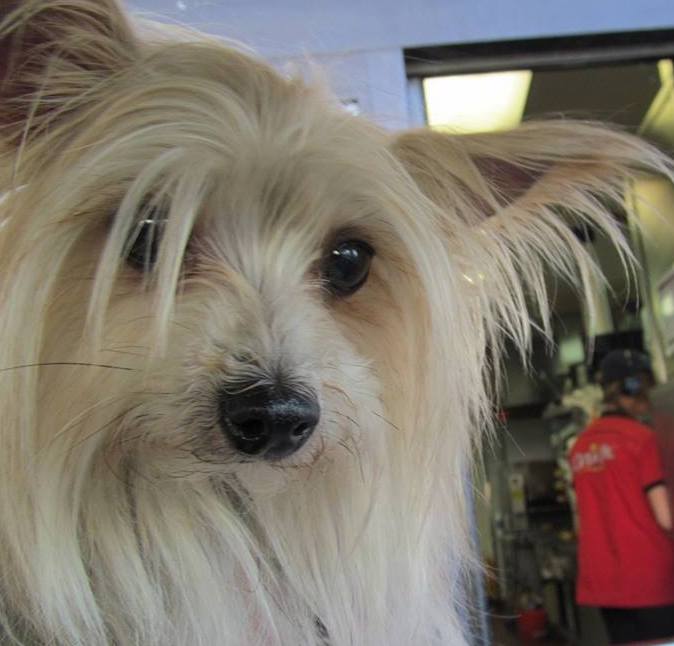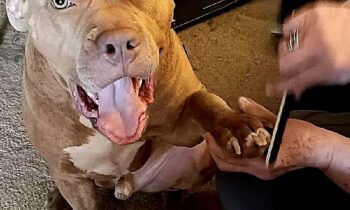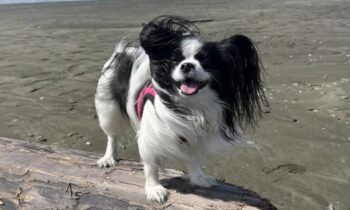
My very old dog is going on 19, based on how well we guessed her age when I found her many years ago. She was close to two or under then, a stray I rescued (literally) from a busy street near my home; I kept her since no one claimed her. I’d always wanted a Toto and this little terrier filled the bill.
In the last few years, she’s lost both sight and hearing. Her once lovely and silky coat no longer rivals that of a show dog. She’s scruffy, sporting a pandemic haircut given to her by me (and I am not a groomer by any means). She’s a little stiff—not surprising at her age—and she had a lot of teeth pulled years ago, typical of a small dog. But as far as I can tell, she’s not suffering from any of the more common issues dogs may have in old age, like canine cognitive dysfunction or doggie dementia.
When I wrote about her most recently, it was October of 2019, and I was wondering how we’d make it through the winter. We did much better than I expected, even with the rickety back steps in the snow and ice.
She did start going “out of bounds” by walking directly off the short end of a step—which meant tumbling into the vegetation around the sides of the steps (luckily, a soft fall), but she did that only twice before I decided to stop the behavior NOW, and devised a way to do that.
I thought about blocking both sides of the steps (she’d tumbled off each side once) and figured I could do that relatively safely using panels from the several small animal cages in the basement. Before I had a chance to try that solution, though, I found a better fix!
As background, she’d earlier taken to stopping on the second-to-the-bottom or bottom step to eliminate, instead of “holding it” until she got on the ground. I’d been using a odd “tool” to encourage her to keep going until she was on the ground—an old (horse) dressage “whip,” the end of which I flicked against the step just above the step she was on, as a sign to “keep going” to the bottom. She had really caught on to that. I could stand at the top of the stairs, out of the way, with no chance of stepping on her, and “direct” her to continue down to the bottom of the stairs. Then I could go inside while she “did her business” in the grass at the bottom of the steps.
Now I realized that I could easily use the thin, stiff dressage whip to “direct” her away from the open sides of the steps—holding it so it only slightly touched her side, preventing her from going off the short step-end.
I got very good at switching the tip of the whip from one side of the dog to the other, depending on which direction she seemed about to move. (It was easy to see her body language from a couple of steps above her.) Eventually she seemed to sense where the whip was, and she directed herself away from it.
(Note: the tool I used is called a whip, but, no, I never used it to touch her punitively in any way. I used it as an extension of my arm to direct her movement away from the step sides.)

Photo by Val Hughes
That’s how we got through the winter without going outside to eliminate becoming a major safety issue for her. I cleared snow and ice from the back steps in what amounted to an open channel for her to go up and down, plus I shoveled the area within a few feet of the steps so she’d have a flat place to potty. Winter weather is not a problem for her, as long as she returns to the warm house soon enough.
So. Steps outside solved, for last winter.
Steps inside became an issue by the spring. She couldn’t go “off the side” of any steps inside the house because none have open sides like the back steps do, so no problem, right? If only.
The stairs inside the house are all uncarpeted hardwood—hence, to a five-pound dog, already slippery. Her stair-climbing method had always been fast and furious, at least until she started losing her eyesight. This spring, something told her to climb quickly and to try to keep climbing when she ran into a corner.
That method did not work at all.
With all the momentum of her furious climb up, her front end hit the corner with her feet still scrabbling to move her forward . . . but there was nowhere to go! Bump, scrabble, slip, and slide—she would start sledding down the stairs if I wasn’t there to stop her.
I started having to “be there” to catch her every single time she went up the stairs, in case she “cornered” herself (which happened just about every time). When she slipped, I could catch her—but it meant I had to pay close attention to where she was and where she was headed every minute she was on the ground floor.
More trouble began with her going down the stairs. She would start down one step and . . . slip, slide, bump, bump, bump. If we both were lucky at that moment, she would end up on the landing.
It’s really remarkable that she survived the few times she “fell” down four or more steps; I credit her small size. Had a big dog taken that fall, it might have broken something.
I wasn’t about to let a broken something happen to her. I knew that would be the end, and I knew I could prevent it. How?
The answer was the same as after the two times she “walked off” the bed: Make Sure That Never Happens Again.
She is no longer allowed to “walk free” upstairs anywhere she might wander into the hallway and tumble down the stairs.
She is no longer left unattended in her bolster bed on my bed. I am either in the room with her or she is in her crate on the floor.
She no longer has access to nor will she ever again be expected to use stairs: I carry her instead. (It would be almost impossible if she weighed more or if she struggled with being carried.)
Coincident with all these other changes, she’d become incontinent on my bed. Just once, mind you, and I was right there to contain the spill and clean it up, thank goodness. Immediately, I made a new rule—considering the incontinence and the walking-off-the-bed incidents that had happened without ill effect (yet).
She is no longer left loose, awake or asleep, on my bed. She is in her kennel, on potty pads, if she is not with me, or outside, and supervised.
Again, I must say, I completely understand that dealing with a dog’s incontinence has to be a whole lot easier when the dog is small. The potty pads are cheaper, you can wash the kennel easily, you can even wash the dog more easily. Everything about incontinence is more difficult when the dog weighs 50 or 100 pounds!
Incontinence is ickier if the dog is no longer able to control her own bowels. We are not, thank goodness, at that point yet with my dog. Most important, the last few months have taught me that as long as she eats the same food in the same amounts every day, with no different food, no different treats (she was always a treat lover), and nothing fed to her that is not her regular food, then her digestive system will produce what it always has: small, solid, scoopable poops. No diarrhea for her to walk through in the kennel—YAY!
I also make sure she eats as much of that regular food as possible to maintain her weight, with as much water as I can include to keep her hydrated, especially during the very hot weather. Most days, she pees and poops each time she goes outside, once or twice a day, without straining or discomfort. The poops in her kennel at night, which are infrequent and small, are easy to clean up and she’s unlikely to walk in them, which is a good thing!
I don’t bathe her as often as I’d like to for the sake of cleanliness and smelling fresh; it can’t be good for her unusually sensitive skin, so we compromise: I tweak her grooming with gentle brushing, I trim a lot of the fur problem areas short, and I may rinse her feet only, depending on what she’s walked through. She’s not the glamour model she was in her younger years, but I do what I can to maintain her dignity, and to keep her personal hygiene acceptable to all of us, her housemates.
This summer, another complication was added to our new routine. I overdid it working outside on one of the hottest days of the year. As a result, I had a bad bout of what appeared to be heat exhaustion. For several days—and even a bit for a few weeks after—I wasn’t completely steady on my pins.
I had to keep carrying the dog up and down the stairs. There was no other choice! I tucked her under one arm, one hand free to hold her tight, the other hand for grabbing onto the bannister to steady myself.
This rough-and-ready solution worked, but only just. I wanted to carry her as safely as possible, but also without clenching her sometimes peed-on self (because she had peed on potty pads in her kennel and walked through it) against my clean clothes, leaving that smell on me for the rest of the day. Yuck!
I ended up wrapping her in a light bath towel, like a burrito, face only sticking out, even her paws covered. Hurray! No residual smell left on me, just on the towel.
Because I could stabilize her and grab tight to the towel, I could hold her close without giving her a chance to struggle. I felt much safer going up and down the hardwood stairs and she was safer, too. So far!
Oddly enough, the towel has become a “cue” for her now. Indoors, she walks out of her kennel and I wrap her up in the towel, pick her up, and carry her downstairs. When she’s been in the back yard, doing her business and getting some exercise, I pick her up, wrapped in the towel, to carry her up the back steps and inside.
Prior to the towel, when I touched her (usually on the shoulder or side) before I picked her up, she would often start with “surprise,” I guess, and then struggle a bit once I had her off the ground. Now instead, the towel has become for her an indication (cue?) that I’m about to pick her up. She stops walking, holds fairly still, and when I do lift her and wrap her in the towel, she struggles much less than she might have in the past—which makes it much easier for me to carry her, too!
I had no intention of “training” her to recognize the towel as a cue to hold still and accept being wrapped up and carried, but I sure like it better that she no longer “starts” with surprise when I touch her. When the towel touches her, it does not make her jump or startle. Don’t ask me why!
Very little that’s happening right now in this little dog’s life has to do with trained behaviors I can tap into as she ages. I think the advantage here for her is that she has “learned how to learn” throughout her life so that even now, when she can no longer rely on her sight and hearing, she is picking up on repeated actions and consistent consequences that allow her to accept her very changed world, as it changes, as a place that’s not unpredictable nor even unsafe.
That must make it better for her, I hope.
EIGHTEEN YEARS AND COUNTING—LIVING WITH A VERY OLD DOG
https://www.fox28spokane.com/eighteen-years-and-counting-living-with-a-very-old-dog/
LIVING WITH A VERY OLD DOG—ADJUSTING TO HER AGING
https://www.fox28spokane.com/living-with-a-very-old-dog-adjusting-to-her-aging/



